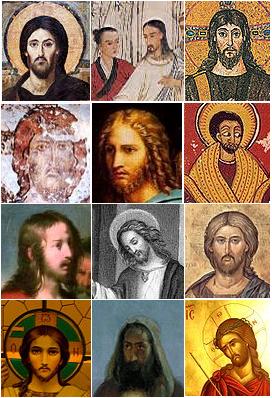In the end, it doesn’t even matter, whether Jesus of Nazareth was white or black. However, speaking in a historical context, maybe its time to ask what was Jesus Christ really like? What color was his skin? Why is Jesus depicted as a having long hair, a beard and of white skin? Was Jesus’ representation always like that? Or did it change throughout time? The answer may surprise you.
Most Historians and Biblical scholars firmly agree that Jesus of Nazareth, born in what is today the capital and the largest city in the Northern District of Israel. In the New Testament, the town is described as the childhood home of Jesus, and as such is a center of Christian pilgrimage, with many shrines commemorating biblical events.
 There is no scholarly agreement on the appearance of Jesus; over the centuries, he has been depicted in a multitude of ways. Image Credit: Wikimedia Commons.
There is no scholarly agreement on the appearance of Jesus; over the centuries, he has been depicted in a multitude of ways. Image Credit: Wikimedia Commons.
This historical fact may shed light on the appearance of Jesus of Nazareth. Is it possible that he had a Middle Eastern Appearance?
Despite His most likely middle-eastern appearance, it has been proven controversial among many experts who argue that Jesus was a white man.
In historical records, we find only a few description of Bible, and those that exist look more towards his divinity and Power, rather than accurately describing his ‘mortal’ appearance.
So, how can we know what Jesus looked like?
 One of the many representations of Jesus. Image Credit: Shutterstock.
One of the many representations of Jesus. Image Credit: Shutterstock.
Most experts agree that in order to understand what Jesus might have looked like we should turn towards the area where He was born.
It is believed that the ancient Jews looked very similar to their Middle-Eastern neighbors, being characterized by having dark skin and hair.
Interestingly, many of the earliest representations of Christ are illustrated in this way, where the artist emphasized on Jesus Christ’s Semitic origins.
However, through the years this changed and the way Jesus was illustrated changed drastically.
Science takes a look
Richard Neave, a scientist at the University of Manchester, has spent a good part of his time trying to reconstruct the face of Jesus of Nazareth through forensic anthropology, one of the subdisciplines of physical anthropology.
It is not the first time that the professor has done a job of this kind, he had previously reconstructed the face of other very popular historical figures, such as Philip II of Macedonia (father of Alexander the Great) and King Midas.
To make an image of Jesus more adapted to reality, the scientist counted on three well-preserved first-century skulls that had been found in Israel. From them, Neave used the computerized tomography to try to obtain even the smallest detail.
 This image was proposed in 2001 by British researchers as the true face of Jesus. Now, forensic anthropology admits that it is the most accurate to date.
This image was proposed in 2001 by British researchers as the true face of Jesus. Now, forensic anthropology admits that it is the most accurate to date.
We are used to seeing representations of Jesus of Nazareth that show him with chestnut hair, white skin, light eyes and a beard.
But science now questions that very Caucasian aspect and claims that His skin color was black, He had a larger nose and also, a much more corpulent appearance.
As explained in Popular Mechanics, scientists believe that this recreation of Jesus could be the most accurate that has been done to date.
According to Alison Galloway, professor of anthropology at the University of California, “it is probably truer to reality than the work of many great masters of painting.”
So, if we know that Jesus was not white, why are we still depicting Him as a white man, brown hair, and a beard?
When Emperor Constantine converted to Christianity, and the religion spread across the Roman Empire, the classic representation of Jesus of Nazareth began to change.
Roman artists started depicting Jesus with long brown hair, with a beard, and white, only to emphasize His connection with the people of the Roman Empire and Europe. Over the centuries this trend would spread across the continent, and the world, where Jesus was depicted as looking more like a Central European man, than someone born in Nazareth.
Featured image credit: Composition-Shutterstock

 Movie
Movie 3 months ago
54
3 months ago
54 






![Presidents Day Weekend Car Sales [2021 Edition] Presidents Day Weekend Car Sales [2021 Edition]](https://www.findthebestcarprice.com/wp-content/uploads/Presidents-Day-Weekend-car-sales.jpg)



 English (United States)
English (United States)